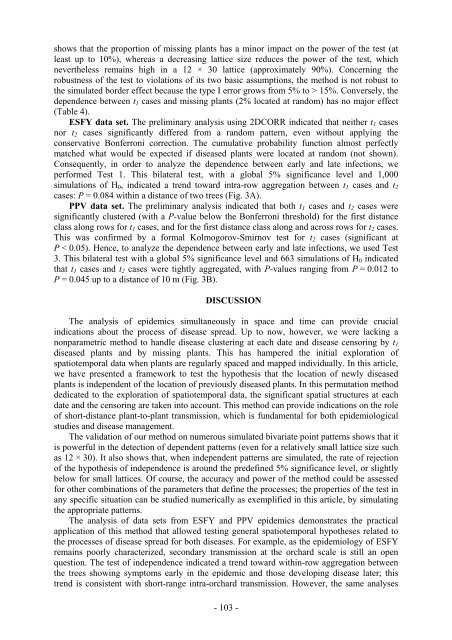Ecole Nationale Supérieure Agronomique de Montpellier ... - CIAM
Ecole Nationale Supérieure Agronomique de Montpellier ... - CIAM
Ecole Nationale Supérieure Agronomique de Montpellier ... - CIAM
You also want an ePaper? Increase the reach of your titles
YUMPU automatically turns print PDFs into web optimized ePapers that Google loves.
shows that the proportion of missing plants has a minor impact on the power of the test (at<br />
least up to 10%), whereas a <strong>de</strong>creasing lattice size reduces the power of the test, which<br />
nevertheless remains high in a 12 × 30 lattice (approximately 90%). Concerning the<br />
robustness of the test to violations of its two basic assumptions, the method is not robust to<br />
the simulated bor<strong>de</strong>r effect because the type I error grows from 5% to > 15%. Conversely, the<br />
<strong>de</strong>pen<strong>de</strong>nce between t1 cases and missing plants (2% located at random) has no major effect<br />
(Table 4).<br />
ESFY data set. The preliminary analysis using 2DCORR indicated that neither t1 cases<br />
nor t2 cases significantly differed from a random pattern, even without applying the<br />
conservative Bonferroni correction. The cumulative probability function almost perfectly<br />
matched what would be expected if diseased plants were located at random (not shown).<br />
Consequently, in or<strong>de</strong>r to analyze the <strong>de</strong>pen<strong>de</strong>nce between early and late infections, we<br />
performed Test 1. This bilateral test, with a global 5% significance level and 1,000<br />
simulations of H0, indicated a trend toward intra-row aggregation between t1 cases and t2<br />
cases: P = 0.084 within a distance of two trees (Fig. 3A).<br />
PPV data set. The preliminary analysis indicated that both t1 cases and t2 cases were<br />
significantly clustered (with a P-value below the Bonferroni threshold) for the first distance<br />
class along rows for t1 cases, and for the first distance class along and across rows for t2 cases.<br />
This was confirmed by a formal Kolmogorov-Smirnov test for t2 cases (significant at<br />
P < 0.05). Hence, to analyze the <strong>de</strong>pen<strong>de</strong>nce between early and late infections, we used Test<br />
3. This bilateral test with a global 5% significance level and 663 simulations of H0 indicated<br />
that t1 cases and t2 cases were tightly aggregated, with P-values ranging from P = 0.012 to<br />
P = 0.045 up to a distance of 10 m (Fig. 3B).<br />
DISCUSSION<br />
The analysis of epi<strong>de</strong>mics simultaneously in space and time can provi<strong>de</strong> crucial<br />
indications about the process of disease spread. Up to now, however, we were lacking a<br />
nonparametric method to handle disease clustering at each date and disease censoring by t1<br />
diseased plants and by missing plants. This has hampered the initial exploration of<br />
spatiotemporal data when plants are regularly spaced and mapped individually. In this article,<br />
we have presented a framework to test the hypothesis that the location of newly diseased<br />
plants is in<strong>de</strong>pen<strong>de</strong>nt of the location of previously diseased plants. In this permutation method<br />
<strong>de</strong>dicated to the exploration of spatiotemporal data, the significant spatial structures at each<br />
date and the censoring are taken into account. This method can provi<strong>de</strong> indications on the role<br />
of short-distance plant-to-plant transmission, which is fundamental for both epi<strong>de</strong>miological<br />
studies and disease management.<br />
The validation of our method on numerous simulated bivariate point patterns shows that it<br />
is powerful in the <strong>de</strong>tection of <strong>de</strong>pen<strong>de</strong>nt patterns (even for a relatively small lattice size such<br />
as 12 × 30). It also shows that, when in<strong>de</strong>pen<strong>de</strong>nt patterns are simulated, the rate of rejection<br />
of the hypothesis of in<strong>de</strong>pen<strong>de</strong>nce is around the pre<strong>de</strong>fined 5% significance level, or slightly<br />
below for small lattices. Of course, the accuracy and power of the method could be assessed<br />
for other combinations of the parameters that <strong>de</strong>fine the processes; the properties of the test in<br />
any specific situation can be studied numerically as exemplified in this article, by simulating<br />
the appropriate patterns.<br />
The analysis of data sets from ESFY and PPV epi<strong>de</strong>mics <strong>de</strong>monstrates the practical<br />
application of this method that allowed testing general spatiotemporal hypotheses related to<br />
the processes of disease spread for both diseases. For example, as the epi<strong>de</strong>miology of ESFY<br />
remains poorly characterized, secondary transmission at the orchard scale is still an open<br />
question. The test of in<strong>de</strong>pen<strong>de</strong>nce indicated a trend toward within-row aggregation between<br />
the trees showing symptoms early in the epi<strong>de</strong>mic and those <strong>de</strong>veloping disease later; this<br />
trend is consistent with short-range intra-orchard transmission. However, the same analyses<br />
- 103 -



